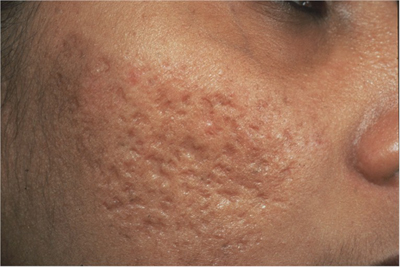Acne Scar Treatments
Product Information
Acne Scar Treatments – 4 Types of Acne Scars

Acne Scar Treatments
There are 4 common types of acne scars: Ice Pick Scars, Boxcar Scars, Rolling Scars and Hypertrophic Scars. We take a closer look at each of these scars and the acne scar treatments.
1 – Ice Pick Scars
Ice pick scars are the most common of the four. As the name suggests, the facial landscape appears to have been assaulted by an “ice pick” or a similar sharp thin tool. The ice pick scars are formed as a result of cystic acne. The inflamed cyst works its way from the lower layer of the skin to the surface thus leaving a deep, long scar. If you were to take an extreme closeup look of this path, it would look like a deep, narrow channel.
Acne scar treatments are available to treat and in some cases eradicate the scars entirely from your face. A popular treatment is a surgical one called a “punch excision”. A tiny tool is used to remove the acne scars. Then the wound is closed by using stitches or skin glue. After healing, the skin look normal. You would never have thought the person suffered from any acne scarring at all. Other forms of natural treatments consists of acne scar cream.
2 – Box Car Scars
Box car scars is the next common acne scar after ice pick scars. Box car scars are not as pronounced as ice pick scars. The box car scars are more wider and not as deep-pitted as ice pick scars. Box car scars are formed after an inflammatory acne breakout. The box car scars has a somewhat sunkened appearance due to the inflammation destroying healthy skin tissues. The box car scars have a circular appearance.
Acne scar treatments are available to treat box car scars. A popular treatment is a surgical one called a “punch elevation”. Here the base of the box car scar is removed and the skin is “lifted” and held in place by surgical surtures so that it will be at the same level as the neighbouring skin. Other forms of natural treatments include skin regenerating cream.
3 – Rolling Scars
The rolling scars has a “rolling”, “wavy”, “band” appearance.
This is formed due to acne lesions whereby a fibrous band of tissue is formed underneath the skin. These bands of tissue pull the skin downwards giving a sunken wave-like appearance.
Acne scar treatments are available to treat rolling scars. The most common method is a surgical one called “subcision”. Here the procedure involves cutting underneath the skin and then using a needle to remove the fibrous tissue which is pulling down the skin. This will then free up the skin to move freely. Other types of treatments involving “checmical peels” whereby the acne scarred skin is exposed to chemicals.
4 – Hypertrophic Scars
This type of scar, unlike the above 3, appears as reddened layers of extra tissues above the skin rather than sunkened.
Acne scar treatments are available to treat hypertophic scars. A common treatment is to inject cortisone and Interferon into the infected area. This may need to be performed more than once (once per month) as this type of scar is quite stubborn to get rid of.
Acne Scar Treatments Summary
As you can see from the above, most of the common acne scar treatments involve some form of surgery. There are also natural ways to treat acne scars. You need to weight the pros and cons of the various methods. As always, discuss your situation with a dermatologist first for their recommendations.
